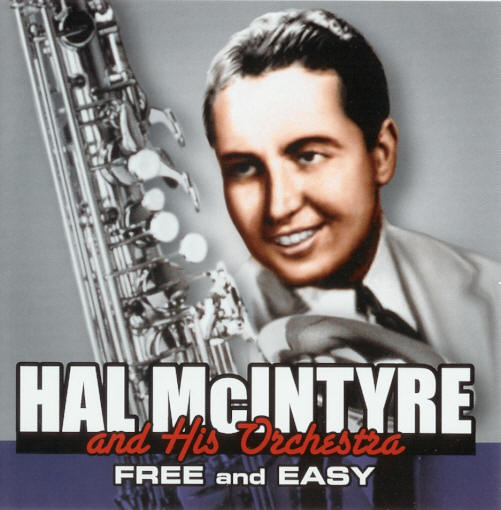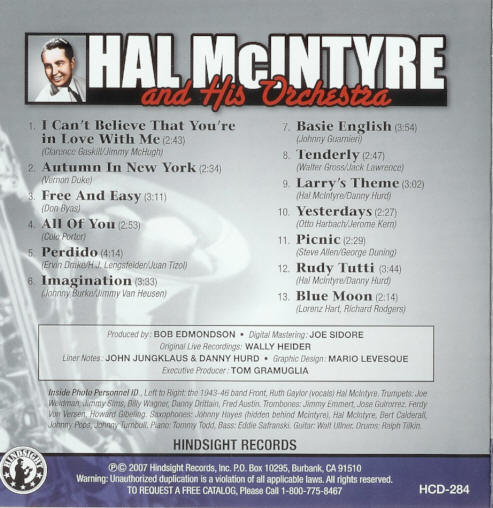Hal McIntyre Big Band, is now
directed by Don Pentleton

Alto saxophonist and bandleader Hal McIntyre formed his
first eight-piece band in 1935. In 1945 after working with Glenn Miller
and Benny Goodman's orchestra, Hal took his band (billed as "The Band
That America Loves") overseas on the USO tour. Featured were
vocalists Gloria Van; Ruth Gaylor and Al Nobel. The group remained
together into the 1950s. This live recording from the '50s
orchestra is a rare and historical document of how the band evolved.
Danny Hurd's notes below offer insight on the glory days 1943-46 for Hal
McIntyre and the Orchestra
John Jungklaus,
Hindsight Records

"You are in for a jazz treat! Masterfully recorded live, this
extraordinary orchestra is captured at its finest. A rare and priceless
collection from a truly great band."
Danny Hurt reflects on the 1940's band in its glory days: Hal
McIntyre and I met by accident, by being in the same place at the same
time, neither of us looking for the other, both of us, it turned out,
looking for something the other had to offer. I had dropped in to
see Leo Talent at Mutual Music, Glenn Miller's New York publisher, to
sign a contract for an original tune I had written for Claude Thornhill.
Hal, who was leaving the Miller band to form his own, had also come to
talk to Leo about the new band.
A prospective band
leader; a pianist is always ready to talk about a job. Leo
introduced us and suggested we talk. When musicians begin to talk
music they usually end up playing what they want to say. I played
a few of my things for Hal there in Leo's office, bit it was what Hal
played for me that told me more about Hal McIntyre and the kind of band
he wanted than all the talking I've forgotten.
To show me
the ballad sound he wanted, Hal played me Duke Ellington's record of "I
Never Felt This Way Before." I remember the beautiful Ben Webster
solo, the unintrusive brass background, the simplicity of the
arrangement. It was tasteful, understated, and it had that sheen
so familiar in the Ellington/Strayhorn mood pieces.
It
was arrangements like this and the bolder Ellington charts like "Chelsea
Bridge" that were to influence the McIntyre ballad style, warm,
full-band sonorities with alto-saxophone solos by Hal, reminiscent of
Duke's way with a pretty tune. And it was meeting Hal for the
first time and discovering his taste for this subtle, silken, style of
playing that made our collaboration so extraordinary for me.
In October, 1941, I joined Hal in the pre-rehearsal stage of putting the
band together, writing the arrangements with Dave Mathews and Howard
Gibeling, heavily influenced by Ellington. Between then and November,
1943, when I left the band to join the U.S. Coast Guard, I think of the
band as having gone through three musically separate periods. The
first, of course, was the Ellington phase, which was de-emphasized
abruptly when one of Hal's managers asked, "When are you going to stop
playing all this Duke stuff?"
That question brought on a
period in the band's history when it seemed to me that all we played
were commercial wartime ballads, but it led to the reaction, the return
to sanity in my opinion when we went back to the tasteful ballads and
duke-inspired originals that featured the unique abilities of the
players.
Danny
Hurd, 1981
Danny Hurd was a pianist and
arranger. He began piano at the age of eight also taking up the
violin, trumpet and later the saxophone and trombone on his own.
He wrote arrangements for Jimmy Dorsey, Ella Fitzgerald, Hal McIntyre,
Claude thornhill, Peggy Lee, Patti Page, and was the musical director
for Liza Minnelli and Chita Rivera in the 1960s.
John Jungklaus, April 2007